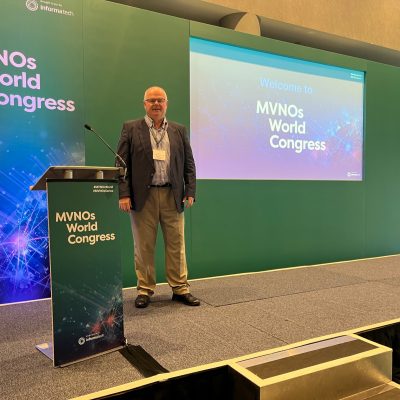Do you know how to stay ahead of the curve and seize opportunities in the MVNO telecom space? I was honoured to have been asked to chair the 2nd day of this year’s MVNOs World Congress which is the leading event for insights and networking in the MVNO industry. In my 10 min introduction to an audience of newbies and veterans, I answered just that and chose to focus on the following areas:
- What are the Macro enablers for MVNOs?
- What challenges are MNOs currently facing?
- What does a Digital First MVNO need to consider?
- MVNO Opportunities.
Macro Enablers
The first consideration is the country, region and location you want to establish your MVNO. This includes looking at the country’s government, demographics, wealth, infrastructure, advancement in digitalisation, access to investment, ARPU etc. This is the inescapable baseline.
Then you must consider the regulatory environment, particularly related to Telecoms and mobile. Not all countries allow MVNOs, some countries do not regulate MVNOs and some countries promote or even force MNOs to accept MVNOs as part of MNO licensing conditions. In any case, it is important to understand the various MNOs and which licenses they have (2G-5G) and what the guidance is related if it is sunsetting 2G or 3G or both. There is of course unlicensed 5G spectrum which could be an option, and this includes WIFI (which is often forgotten about).
Moving towards 5G is not just an increase in bandwidth for the end user. It requires a route and branch investment for Operators from the transport to the core as well as access as you will need more RAN sites to cover the same area, particularly if higher radio bandwidth is used. There is substantial investment required and some heavy lifting to make the user experience seamless. As an MVNO you will need to do your research and ensure that you have the right MNO partner, who in turn can have quite different infrastructure and licenses. Often in a given market, you will find the challenger MNOs will want to be creative in winning market share and be more receptive to MVNOs compared to the incumbents.
Finally, as an MVNO you will need to understand the end-user devices ecosystem in the market which will also potentially limit the type of services devices can support. Despite initiatives to drive down the costs of smartphones, in reality, there is still a large portion of the globe either unconnected or using simpler feature phones.
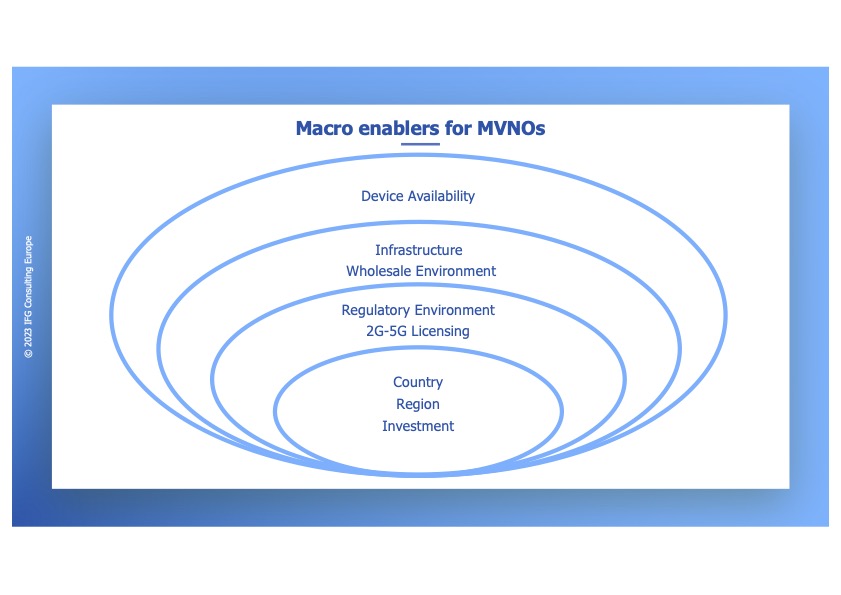
Operator challenges
At the opening address at this year’s MWC, several of the leading CEOs of the large telcos confirmed that 95% of their investment will be in 5G. As we all know, Telecoms is a capital-intensive business and lots of these Operators are already heavily leveraged with little headroom for borrowing. In addition, customers whether businesses or consumers are expecting price erosion and next-generation services to be delivered at price parity which is very difficult to finance and is not a good investment.
90% of a mobile operator’s costs are in running the RAN and hence there is a drive to reduce these. Due to the higher frequency in 5G, there will be a need for an increase in density of sites. Given the economics of renting sites and managing towers, there is an economic efficiency to be achieved through pooling these sites and resources. There are several TowerCo’s now in the market who are buying up sites with the intention of renting them back to multiple Operators. It can be expected that these TowerCo’s want to increase their value by also offering to manage active elements. To further reduce costs, Operators are wanting to reduce their dependency on one or two large NEVs with initiatives such as ORAN alliance to disaggregate the network.
Furthermore, due to the transition to a platform as a service (PaaS) or network as a service (NaaS) Operators are wanting to split the business between network NetCo’s and ServCos. ServCo’s being the business unit serving the customer. This means that ServCo’s will be almost indistinguishable to MVNO’s with regards to their scope of operations, focus and remit.
You would have thought that Operators would be masters of running data centres and cloud. Increasingly instead of streamlining their own cloud, Operators are moving workloads to the hyper-scaler’s. Some of whom have already announced 5GSA solutions and become MVNO’s themselves, which could be a natural evolution. (Amazon bundling Amazon Prime with phone bundles).
Operators will finally be sunsetting (switching off) 2G/ 3G services with variable timelines per country. There will still be a sizeable part of the MVNO market who are not on 4G and an MVNO needs to work closely with Operators to achieve a smooth transition.
There is unprecedented change in the RAN area as Operators move towards disaggregation software-driven RAN to replace the current oligopoly. This is proving to be harder to achieve than expected but should lead to the cost of providing RAN being lower even for MVNOs in the future.
Device availability is key for any service not just regarding functionality but price point. An appropriate price point has hampered the adoption of smartphones in developing countries and scarcity of adequate 5G devices has limited the rollout of 5G in developed countries.
Up to now, connectivity has predominantly been terrestrial, but due to the advancement of satellites, we are seeing coverage being enabled from above (GEO Orbit) with increasing broadband speeds. Although still viewed as a complimentary service to Operators, there is no reason why there won’t be MVNOs who focus their service from above.
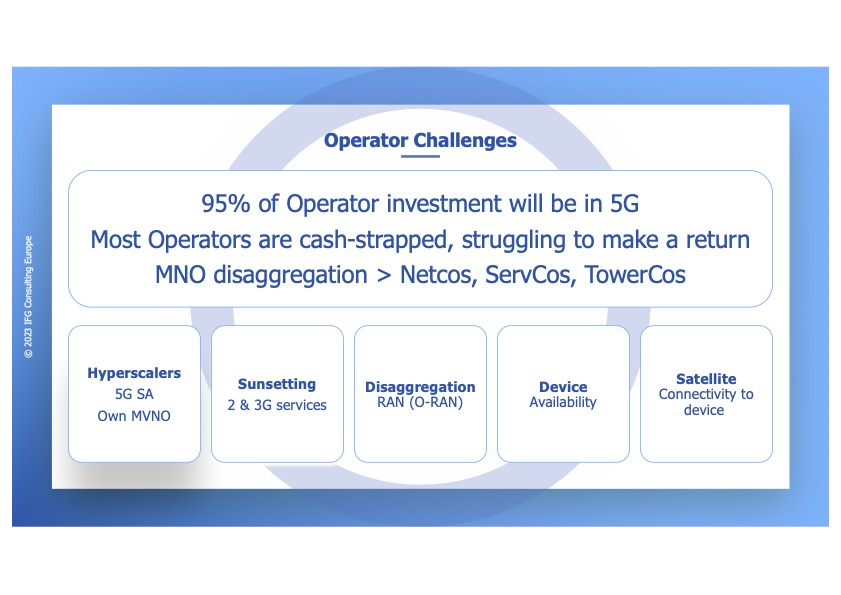
Digital First MVNOs
If you want to become an MVNO, then digital first is the way to go due to cost efficiencies, improved customer experience and possibilities for customer engagement.
Other technical innovations you might want to leverage as part of your proposition are:
- eSIM digital first SIM cards, which can be downloaded digitally. Some devices led by Apple will be eSIM only and they are much more convenient for users, enabling a 2nd identity on the same device, in-country offers when travelling and remote provisioning for B2B and IoT applications.
- Cloud is enabling the utilisation of services on-demand, allowing you to scale more quickly in-line with your growth, reducing the upfront investments.
- Crypto-currencies, although not allowed everywhere, if an Operator accepted crypto-currencies as payment it would be a smart way to drive loyalty and be able to build a trading ecosystem around the brand with added value services.
- Blockchain could be utilised as part of the cryptocurrency but could also be used in conjunction with asset management in a B2B context related to IoT.
- Operators are having to change both their IT and Network architecture embracing automation and exposing services both internally and externally via API. This should make it easier for any MVNO to consume Operator services.
- MVNOs should have access to a unique set of data related to their subscribers and using ML/AI provide insights and services both for internal operational efficiency and customer engagement.
- To efficiently service their MVNOs some Operators want to offer a slice. This provides additional control over the E2E QoS, which might be part of the end user’s service.
- Statistics show that on average mobile subscribers are on WIFI 80% of the time and almost permanently when indoors. Therefore, improved connectivity beyond mobile is key and can be of benefit. One of the main user cases in 5G is FWA where 5G is used as the modem backhaul with users on WIFI.
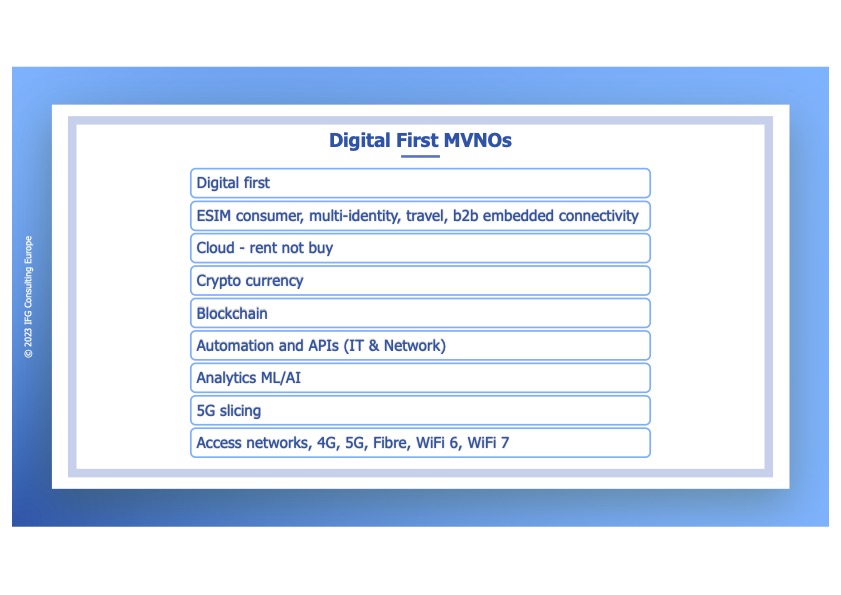
MVNO Opportunities
In my view, there are 4 main areas of opportunity for MVNO’s:
Consumer niches – As an MVNO it is very important to make sure that you are adding value and can demonstrate a different value proposition compared to the host Operator as the account manager of the MNO will have to justify internally why they should host you on their network.
FWA – Fixed wireless access both 4G and 5G could be interesting particularly to serve rural areas where digging fibre is prohibitive. As there is no physical connection required this service can be up and running very quickly assuming there is coverage. Some MNOs who also have fixed-line businesses will be reluctant to offer this themselves as it would be seen as cannibalising their fixed-line broadband service.
IoT (vertical specialisation) – It has been commonly understood that only 10% of an IoT solution’s value and charge relates to connectivity. This means that if you want to provide value then you need to consider the needs of the verticals you service and provide added value services, allowing you to command a higher share of the value.
B2B SME market – Large telecoms will focus their efforts on supporting large enterprises, leaving SMEs to accept standard (consumer-like services). However, SMEs will have specialist needs which is where MVNOs can add value and should have their own core network. Ideally, an SME will be looking for one partner who can service their communication needs independently of fixed or mobile access. This is how I see the connectivity reseller market evolving.
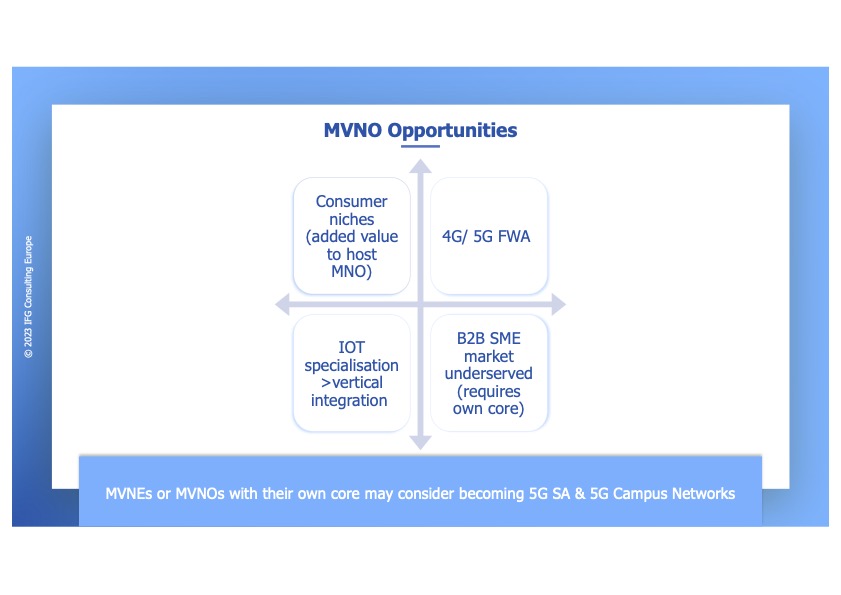
Hopefully, by reading this you are more aware of ideas to stay ahead of the curve and seize opportunities in the MVNO telecom space. As a last consideration, those MVNEs and MVNOs who own their own core have the fundamental capabilities to service the 5G SA and 5G Campus networks. You heard it here first!

